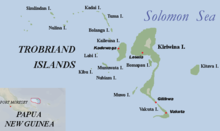Kiriwina spiked-nosed sacs
| Kiriwina spiked-nosed sacs | ||||||||||||
|---|---|---|---|---|---|---|---|---|---|---|---|---|
| Systematics | ||||||||||||
|
||||||||||||
| Scientific name | ||||||||||||
| Echymipera davidi | ||||||||||||
| Flannery , 1990 |
The Kiriwina spiked -nosed bucket ( Echymipera davidi ) is a species of marsupial known only from the island of Kiriwina, which belongs to the Trobriand Islands southeast of New Guinea.
features
So far, only two males of the Kiriwina spiked-nosed bucket have been measured. They had a head body length of 32 and 40 cm. One of the animals had a 10.8 cm tail and a weight of 950 g. Dimensions for female animals are not available. The Kiriwina spiked nose bag is uniformly brown in color. Both soft and bristly hair can be found in the fur. The snout is relatively short compared to that of other nasal aspirators. The ears are small and dark. The tops of the fore and hind feet are covered with short, brown hair. In contrast to the red sting-nosed pouch ( Echymipera rufescens ) and the Clara sting-nosed pouch ( Echymipera clara ), the soles of the hind feet are not dark.
Habitat and way of life
The island of Kiriwina is densely populated by humans. Only small areas of the flat, maximum 100 meters high island consist of primary forest or swamps that have not been affected by humans. The Kiriwina spiked-nosed bucket apparently also lives in young secondary forests near human settlements. So far, nothing is known about nutrition, reproductive behavior and other behavior.
Danger
The IUCN lists the Kiriwina spiny-nosed bucket as Endangered, but few data are available to assess the status of the species. The island of Kiriwina is very small (545 km²) and densely populated by humans. The habitat used by the Kiriwina sting-nosed bucket is said to be only 280 km² in size. It is not yet known whether the animals can also be found on other Trobriand Islands.
supporting documents
- ↑ a b Christopher Dickman: Family Peramelidae (Bandicoots and Echymiperas). in Don E. Wilson , Russell A. Mittermeier : Handbook of the Mammals of the World - Volume 5. Monotremes and Marsupials. Lynx Editions, 2015, ISBN 978-84-96553-99-6 , page 395.
- ↑ Echymipera davidi in the endangered Red List species the IUCN 2016 Posted by: Leary, T. Wright, D., Hamilton, S., Singadan, R. Menzies, J., Bonaccorso, F. Salas, L. , Seri, L., Dickman, C., Helgen, K. & Aplin, K., 2016. Retrieved September 2, 2018.
